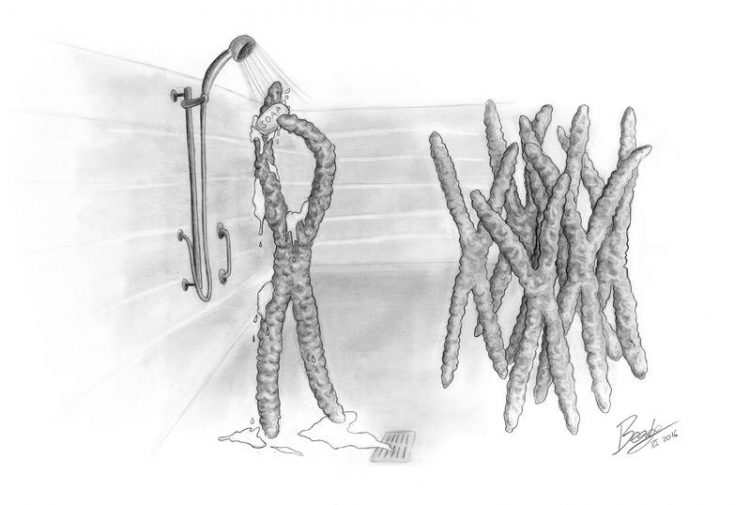A protein coat helps chromosomes keep their distance

The surface of chromosomes is covered with surfactant-like proteins during cell division. These proteins act similar to soap to disperse chromosomes and prevent them from clustering together. IMBA/Mierzwa
Billions of your cells divide every day. Cell division fuels growth and also replaces short-lived cells in some organs, like your skin, blood, and gut.
Dividing cells cycle through different stages. During most of this cycle, cells are at work expressing genes. At this stage chromosomes are spread out as a network of long threads that fill the entire volume of the cell nucleus.
As the cell prepares to divide, the chromosomes replicate and undergo a dramatic metamorphosis. They compact into iconic X-shaped bodies which can move around independently to transport one copy of the genome to each of the daughter cells. But what enables this “individualization” of chromosomes in dividing cells has been a mystery.
A team led by Daniel Gerlich at IMBA discovered that the protein Ki-67 prevents
chromosomes from sticking together in dividing cells. Ki-67 is a well-known marker of proliferating cells and is used in cancer diagnostics to measure erratic cell division. But the function of Ki-67 in the cell was unclear. Their findings, published in the current issue of Nature, show that the chromosomes can still compact without Ki-67, but they merge into a single mass and are essentially immobile. As a consequence, cells lacking Ki-67 divide more slowly.
The team set out to determine how Ki-67 disperses chromosomes in dividing cells. Sara Cuylen, first author of the study, explains: “one end of the Ki-67 protein is attracted to chromosomes, whereas the other end extends away from them.
As a result, Ki-67 forms elongated brush-like structures at the chromosome surface – essentially a barrier that keeps them apart.” These properties of Ki-67 are reminiscent of surface-active agents (surfactants) like soap – which we use daily to break up dirt and grease. That proteins can function as surfactants inside the cell was completely unexpected.
Daniel Gerlich points out that a surfactant mechanism might also control the spatial arrangement of other cell organelles: “The cell contains many other compartments that are not confined by membranes and it was previously unknown how these compartments maintain spatial separation. It will be exciting to search for other proteins with surfactant-like properties, and to study their potential role in cellular organization”.
Original publication: Cuylen, S., Blaukopf, C., Politi, A.Z., Müller-Reichert, T., Neumann, B., Poser, I., Ellenberg, J., Hyman, A.A., Gerlich, D.W. (2016), Ki-67 acts as a biological surfactant to disperse mitotic chromosomes. Nature DOI: 10.1038/nature18610
Press contact:
Ines Méhu-Blantar
IMBA Communications
Dr. Bohr Gasse 3, 1030 Vienna, Austria
Tel.: +43 664 80847 – 3628
Ines.mehu-blantar@imba.oeaw.ac.at
Weitere Informationen:
http://www.imba.oeaw.ac.at/
http://de.imba.oeaw.ac.at/index.php?id=516 (Press pictures)
Media Contact
All latest news from the category: Life Sciences and Chemistry
Articles and reports from the Life Sciences and chemistry area deal with applied and basic research into modern biology, chemistry and human medicine.
Valuable information can be found on a range of life sciences fields including bacteriology, biochemistry, bionics, bioinformatics, biophysics, biotechnology, genetics, geobotany, human biology, marine biology, microbiology, molecular biology, cellular biology, zoology, bioinorganic chemistry, microchemistry and environmental chemistry.
Newest articles

Superradiant atoms could push the boundaries of how precisely time can be measured
Superradiant atoms can help us measure time more precisely than ever. In a new study, researchers from the University of Copenhagen present a new method for measuring the time interval,…

Ion thermoelectric conversion devices for near room temperature
The electrode sheet of the thermoelectric device consists of ionic hydrogel, which is sandwiched between the electrodes to form, and the Prussian blue on the electrode undergoes a redox reaction…

Zap Energy achieves 37-million-degree temperatures in a compact device
New publication reports record electron temperatures for a small-scale, sheared-flow-stabilized Z-pinch fusion device. In the nine decades since humans first produced fusion reactions, only a few fusion technologies have demonstrated…





















